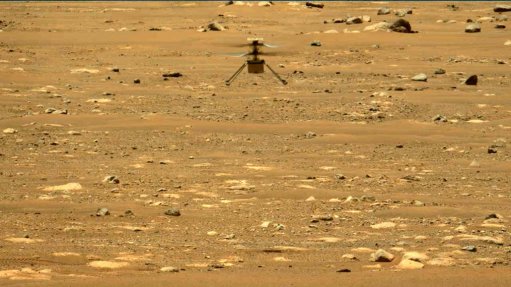
Ingenuity photographed by the Perseverance rover during the helicopter’s second flight
Photo by: Nasa
The US National Aeronautics and Space Agency (Nasa) has announced that its Ingenuity drone helicopter made a successful second flight on Mars on Thursday. This flight, although still brief, significantly expanded the machine’s flight envelope. The little helicopter and its control algorithms were developed by a dedicated team at Nasa’s famed Jet Propulsion Laboratory (JPL), in California.
Ingenuity is a 49 cm high, 1.8 kg mass, solar energy-powered technology demonstrator, fitted with contra-rotating rotors. On its second flight, it reached an altitude of 5 m (compared with 3 m on its first flight). Total flight duration was 51.9 seconds (the duration of the first flight had been 39.1 seconds).
But on this second flight, instead of just hovering, the helicopter tilted slightly (by five degrees), thereby generating some thrust with its rotors. It then moved sideways for 2 m. It stopped, hovered and executed a number of turns to point its camera in different directions. It then tilted again and flew back to its original position and landed in the centre of the area now called Wright Brothers Field.
“It sounds simple, but there are many unknowns regarding how to fly a helicopter on Mars,” pointed out JPL Ingenuity chief pilot Håvard Grip. “That’s why we’re here – to make these unknowns known.”
“So far, the telemetry we have received and analysed tell us that the flight met expectations and our prior computer modelling has been accurate,” reported Nasa JPL Ingenuity Mars Helicopter chief engineer Bob Balaram. “We have two flights of Mars under our belts, which means that there is still a lot to learn during this month of Ingenuity.”
Ingenuity is intended to establish whether or not aircraft can operate in the very thin Martian atmosphere (the surface pressure of which is only 1% of atmospheric surface pressure on Earth). As such, it carries no scientific sensors. But each flight it makes provides Nasa with lots of data to compare with tests, simulations and modelling carried out on Earth.
The Ingenuity team is now considering how best to further expand the helicopter’s flight envelope and obtain the maximum possible aeronautical data. The programme opens the way to the future deployment on Mars of sensor-equipped drone helicopters that would be able to gather scientific data and massively expand the horizons of future Mars missions.
Ingenuity was transported to Mars in the belly of Nasa’s Perseverance lander, and subsequently deployed on to the Martian surface. Perseverance mounts Ingenuity’s base station, which stores and relays communications between the drone and Earth. The helicopter has to be autonomous because of the time lag in sending and receiving signals between Earth and Mars.